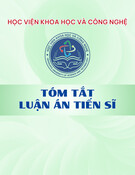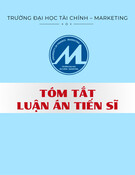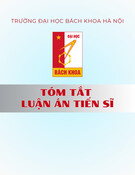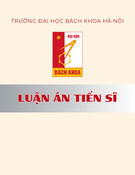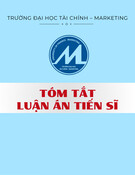
Annals of Mathematics
Hochschild cohomology of
factors with property Γ
By Erik Christensen, Florin Pop, Allan M. Sinclair,
and Roger R. Smith†

Annals of Mathematics, 158 (2003), 635–659
Hochschild cohomology of factors
with property Γ
By Erik Christensen∗, Florin Pop, Allan M. Sinclair,
and Roger R. Smith†
Dedicated to the memory of Barry Johnson, 1937–2002
Abstract
The main result of this paper is that the kth continuous Hochschild co-
homology groups Hk(M,M) and Hk(M,B(H)) of a von Neumann factor
M⊆B(H)oftypeII
1with property Γ are zero for all positive integers k.
The method of proof involves the construction of hyperfinite subfactors with
special properties and a new inequality of Grothendieck type for multilinear
maps. We prove joint continuity in the ·
2-norm of separately ultraweakly
continuous multilinear maps, and combine these results to reduce to the case
of completely bounded cohomology which is already solved.
1. Introduction
The continuous Hochschild cohomology of von Neumann algebras was ini-
tiated by Johnson, Kadison and Ringrose in a series of papers [21], [23], [24]
where they developed the basic theorems and techniques of the subject. From
their results, and from those of subsequent authors, it was natural to conjec-
ture that the kth continuous Hochschild cohomology group Hk(M,M)ofa
von Neumann algebra over itself is zero for all positive integers k. This was
verified by Johnson, Kadison and Ringrose, [21], for all hyperfinite von Neu-
mann algebras and the cohomology was shown to split over the center. A
technical version of their result has been used in all subsequent proofs and is
applied below. Triviality of the cohomology groups has interesting structural
implications for von Neumann algebras, [39, Chapter 7] (which surveys the
original work in this area by Johnson, [20], and Raeburn and Taylor, [35]), and
so it is important to determine when this occurs.
∗Partially supported by a Scheme 4 collaborative grant from the London Mathematical Society.
†Partially supported by a grant from the National Science Foundation.

636 E. CHRISTENSEN, F. POP, A. M. SINCLAIR, AND R. R. SMITH
The representation theorem for completely bounded multilinear maps, [9],
which expresses such a map as a product of ∗-homomorphisms and interlacing
operators, was used by the first and third authors to show that the completely
bounded cohomology Hk
cb(M,M)isalways zero [11], [12], [39]. Subsequently
it was observed in [40], [41], [42] that to show that Hk(M,M)=0, it suffices
to reduce a normal cocycle to a cohomologous one that is completely bounded
in the first or last variable only, while holding fixed the others. The multilinear
maps that are completely bounded in the first (or last) variable do not form
aHochschild complex; however it is easier to check complete boundedness in
one variable only [40]. In joint work with Effros, [7], the first and third authors
had shown that if the type II1central summand of a von Neumann algebra M
is stable under tensoring with the hyperfinite type II1factor R, then
(1.1) Hk(M,M)=Hk
cb(M,M)=0,k≥2.
This reduced the conjecture to type II1von Neumann algebras, and a fur-
ther reduction to those von Neumann algebras with separable preduals was
accomplished in [39, §6.5]. We note that we restrict to k≥2, since the case
k=1,inadifferent formulation, is the question of whether every derivation of
avon Neumann algebra into itself is inner, and this was solved independently
by Kadison and Sakai, [22], [38].
The noncommutative Grothendieck inequality for normal bilinear forms
on a von Neumann algebra due to Haagerup, [19] (but building on earlier work
of Pisier, [31]) and the existence of hyperfinite subfactors with trivial relative
commutant due to Popa, [33], have been the main tools for showing that suit-
able cocycles are completely bounded in the first variable, [6], [40], [41], [42].
The importance of this inequality for derivation problems on von Neumann
and C∗-algebras was initially observed in the work of Ringrose, [36], and of the
first author, [4]. The current state of knowledge for the cohomology conjecture
for type II1factors may be summarized as follows:
(i) Mis stable under tensoring by the hyperfinite type II1factor R,k≥2,
[7];
(ii) Mhas property Γ and k=2,[6],[11];
(iii) Mhas a Cartan subalgebra, [32, k= 2], [8, k= 3], [40, 41, k≥2];
(iv) Mhas various technical properties relating to its action on L2(M,tr) for
k=2,([32]), and conditions of this type were verified for various classes
of factors by Ge and Popa, [18].
The two test questions for the type II1factor case are the following. Is
Hk(M,M) equal to zero for factors with property Γ, and is H2(VN(
F
2),
VN(
F
2)) equal to zero for the von Neumann factor of the free group on two
generators? The second is still open at this time; the purpose of this paper

HOCHSCHILD COHOMOLOGY 637
is to give a positive answer to the first (Theorems 6.4 and 7.2). If we change
the coefficient module to be any containing B(H), then the question arises of
whether analogous results for Hk(M,B(H)) are valid (see [7]). We will see
below that our methods are also effective in this latter case.
The algebras of (i) above are called McDuff factors, since they were studied
in [25], [26]. The hyperfinite factor Rsatisfies property Γ (defined in the next
section), and it is an easy consequence of the definition that the tensor product
of an arbitrary type II1factor with a Γ-factor also has property Γ. Thus, as is
well known, the McDuff factors all have property Γ, and so the results of this
paper recapture the vanishing of cohomology for this class, [7]. However, as
was shown by Connes, [13], the class of factors with property Γ is much wider.
This was confirmed in recent work of Popa, [34], who constructed a family of
Γ-factors with trivial fundamental group. This precludes the possibility that
they are McDuff factors, all of which have fundamental group equal to
R
+.
The most general class of type II1factors for which vanishing of coho-
mology has been obtained is described in (iii). While there is some overlap
between those factors with Cartan subalgebras and those with property Γ, the
two classes do not appear to be directly related, since their definitions are quite
different. It is not difficult to verify that the infinite tensor product of an arbi-
trary sequence of type II1factors has property Γ, using the ·
2-norm density
of the span of elements of the form x1⊗x2⊗···⊗xn⊗1⊗1···.Voiculescu, [44],
has exhibited a family of factors (which includes VN(
F
2)) having no Cartan
subalgebras, but also failing to have property Γ. This suggests that the infinite
tensor product of copies of this algebra might be an example of a factor with
property Γ but without a Cartan subalgebra. This is unproved, and indeed
the question of whether VN(
F
2)⊗VN(
F
2) has a Cartan subalgebra appears to
be open at this time. While we do not know of a factor with property Γ but
with no Cartan subalgebra, these remarks indicate that such an example may
well exist. Thus the results of this paper and the earlier results of [40] should
be viewed as complementary to one another, but not necessarily linked.
We now give a brief description of our approach to this problem; definitions
and a more extensive discussion of background material will follow in the next
section. For a factor Mwith separable predual and property Γ, we construct
ahyperfinite subfactor R⊆Mwith trivial relative commutant which enjoys
the additional property of containing an asymptotically commuting family of
projections for the algebra M(fifth section). In the third section we prove a
Grothendieck inequality for R-multimodular normal multilinear maps, and in
the succeeding section we show that separate normality leads to joint conti-
nuity in the ·
2-norm (or, equivalently, joint ultrastrong∗continuity) on the
closed unit ball of M. These three results are sufficient to obtain vanishing
cohomology for the case of a separable predual (sixth section), and we give the
extension to the general case at the end of the paper.

638 E. CHRISTENSEN, F. POP, A. M. SINCLAIR, AND R. R. SMITH
We refer the reader to our lecture notes on cohomology, [39], for many
of the results used here and to [5], [13], [15], [25], [26], [27] for other material
concerning property Γ. We also take the opportunity to thank Professors
I. Namioka and Z. Piotrowski for their guidance on issues related to the fourth
section of the paper.
2. Preliminaries
Throughout the paper Mwill denote a type II1factor with unique nor-
malized normal trace tr. We write xfor the operator norm of an element
x∈M, and x2for the quantity (tr(xx∗))1/2, which is the norm induced by
the inner product x, y= tr(y∗x)onM.
Property Γ for a type II1factor Mwasintroduced by Murray and
von Neumann, [27], and is defined by the following requirement: given x1,...,
xm∈Mand ε>0, there exists a unitary u∈M, tr(u)=0,such that
(2.1) uxj−xju2<ε, 1≤j≤m.
Subsequently we will use both this definition and the following equivalent for-
mulation due to Dixmier, [15]. Given ε>0, elements x1,...,x
m∈M, and
apositive integer n, there exist orthogonal projections {pi}n
i=1 ∈M, each of
trace n−1and summing to 1, such that
(2.2) pixj−xjpi2<ε, 1≤j≤m, 1≤i≤n.
In [33], Popa showed that each type II1factor Mwith separable
predual contains a hyperfinite subfactor Rwith trivial relative commutant
(R′∩M=
C
1), answering positively an earlier question posed by Kadison. In
the presence of property Γ, we will extend Popa’s theorem by showing that R
may be chosen to contain, within a maximal abelian subalgebra, projections
which satisfy (2.2). This result is Theorem 5.3.
We now briefly recall the definition of continuous Hochschild cohomology
for von Neumann algebras. Let XbeaBanach M-bimodule and let Lk(M,X)
be the Banach space of k-linear bounded maps from the k-fold Cartesian prod-
uct Mkinto X,k≥1. For k=0,wedefine L0(M,X)tobeX. The cobound-
ary operator ∂k:Lk(M,X)→L
k+1(M,X) (usually abbreviated to just ∂)is
defined, for k≥1, by
∂φ(x1,...,x
k+1)=x1φ(x2,...,x
k+1)(2.3)
+
k
i=1
(−1)iφ(x1,...,x
i−1,x
ixi+1,x
i+2,...,x
k+1)
+(−1)k+1φ(x1,...,x
k)xk+1,


